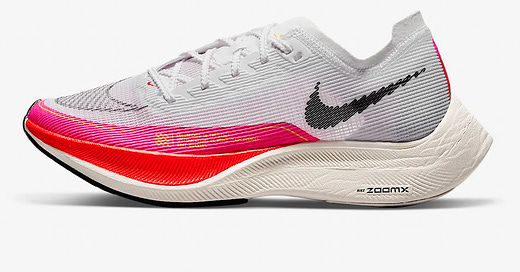Noah here. Back in November of 2019, WITI contributor Reess Kennedy wrote the Vaporfly 4% Edition, noting the sea of pink feet in the 2019 New York City Marathon. Those pink sneakers were Nike Vaporflys, at the time the company’s high-performance distance running shoe. Sporting a carbon-fiber plate and extra special foam, the shoes promised (and delivered) a 4% performance increase.
How did they do that? According to Runner’s World, it’s three reasons. First, they stabilize the ankle. Second, they hold the toes straight. “And third, the ZoomX foam in the midsole has two unique properties: an unusual degree of compliance (it squishes when your foot lands) and an unusual degree of resilience (it springs back to its original shape, returning most of the energy your foot applied when you landed). In fact, the shoe has 80 percent energy return in the heel, which is the highest we’ve ever measured in our Runner’s World shoe lab.”
At this point, the shoe’s bona fides are well-established. So much so that in early 2020, World Athletics, which governs track and field, established a new set of footwear guidelines aimed at curbing prototype footwear with more plates and bigger foam from completely dominating the sport.
Why is this interesting?
These shoes are so good and essential to performance that a fascinating second-order effect has emerged: athletes are opting out of their sponsorship deals to race with the best gear. From a fascinating article by Martin Fritz Huber at Outside:
In Boston, Scott Fauble and Nell Rojas were the fastest Americans in the men’s and women’s races, running PRs of 2:08:52 and 2:25:57, respectively. Both athletes had recently opted out of their sponsorship contracts and were running unattached; Fauble decided not to renew his relationship with Hoka late last year, while Rojas had ended her contract with Adidas prior to Boston after only a few months with the brand. Fauble maintained that his decision was based on the fact that he had hit a plateau and wanted * to take his training in a new direction, but Rojas said that Adidas’s racing shoes were not a good fit for her. In Boston, both athletes ended up running their fastest marathons to date in Nike’s Alphafly racer, despite not having deals with the company. Viewed from a certain angle, their success seemed to be an unintentional endorsement for Nike, a brand whose product was so good that the best American runners had chosen to race in it without being paid to do so.
While other shoes are still winning races—both winners in the Boston marathon were wearing Adidas—many runners seem to prefer the way the Nike shoes race. Not only has this created a strange situation with current sponsorships, but apparently, it’s also hugely shifted the balance of power in negotiations for new ones. If a shoe company knows you prefer their shoes so much you’ll wear them anyway, what incentive do they have actually to sponsor you?
While running sponsorships are still far behind many other sports, any athlete leaving money on the table is a meaningful gesture. Sometimes that can be forgotten when money in sports is calibrated off the big dollars of soccer, basketball, American football, and the like. But it speaks to the commitment these runners, and professional athletes all over sports, have to their craft. These competitors are leaving meaningful dollars on the table for the chance to be faster. And although the gap between Nike and the field will surely close (as it has since the technology was originally introduced), this feels connected to broader marketing trends around authenticity. In a moment when every YouTube creator and podcast host promises us that a coffee subscription and mattress changed their life (and might change yours!), it’s fun to imagine a world where these signals actually mean something. (NRB)
--
WITI x McKinsey:
An ongoing partnership where we highlight interesting McKinsey research, writing, and data.
Mind the (generation) gap. Are you part of Gen Z, or interested in what matters to Zs because you work with or manage them? Don’t miss McKinsey’s new weekly newsletter, Mind the Gap. You’ll get curated reads on today’s hot topics, from mental health to inclusion at work, inflation’s effect on young consumers, and beyond. Check it out.
–-
Thanks for reading,
Noah (NRB) & Colin (CJN)
—
Why is this interesting? is a daily email from Noah Brier & Colin Nagy (and friends!) about interesting things. If you’ve enjoyed this edition, please consider forwarding it to a friend. If you’re reading it for the first time, consider subscribing (it’s free!).




